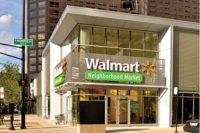
Once featuring large stores selling primarily hardlines with a dash of grocery, leading mass merchandise retailers, including Target, Wal-Mart and Kmart, have converted so many stores to supercenters that the traditional mass merchandise channel fell more than 5 percent and is expected to decline almost 7 percent into 2014, according to “The Future of Food Retailing,” an annual report from Willard Bishop LLC, Barrington, Ill.
Supercenters can be defined as a hybrid of mass merchandise and traditional supermarket outlets. In 2009, they accounted for 16.7 percent share of grocery and consumables, compared with only 4.3 percent for mass merchandisers, Willard Bishop reports. Sales continue to grow in supercenters, up 7.8 percent to $164.1 billion with more than 3,300 stores in 2009, according to the firm.
“Mass retailers are moving more aggressively into food for strategic reasons, to build trip frequency and basket size,” says Jim Hertel, Willard Bishop managing partner. “And they have broadly adopted the supercenter format that incorporates a full-line supermarket.”
SymphonyIRI, Chicago, defines supercenters as mass merchandise stores with extensive grocery selections. The research firm reports supercenters posted dollar share gains across consumer product goods (CPG) channels, currently holding 18.9 percent dollar share of CPG sales.
Supercenters have grown the fastest during the past five years, says Todd Hale, senior vice president of consumer and shopper insights at The Nielsen Co., New York. Much of the slip in traditional mass merchandisers can be attributed to Wal-Mart’s conversion of so many stores. There’s “a lot of growth behind the big boxes,” he says.
“Hypermarkets” drew consumer attention in 2009 because of the one-stop shopping appeal for grocery and general merchandise, says Alison Lipson, U.S. research analyst at Euromonitor International, Chicago. However, she asserts that much of 2010 has shown mass merchandise outlets fighting back “as many continue to add a greater selection of food.”
Recessionary spending
Undoubtedly the recession changed Americans’ approach to shopping. Where consumers once were habitual in where they shopped and had brand allegiance, “a lot of consumers are questioning that now,” The Nielsen Co.’s Hale says. “… We went from a period where we were spending nearly every dollar we had to today, when consumers are trying to save and pay down debt.”
Still wary of spending, experts agree that the recession might have changed shopping patterns indelibly, at least to some extent, and supercenters have become part of new routines given the convenience of one-stop shopping.
“There is a shift to the ‘new normal’ where less is more,” Euromonitor’s Lipson says. “Consumers are slowly beginning to start purchasing some discretionary items, but still feel a bit beaten by the recession. They are shopping for value, but also convenience.”
According to SymphonyIRI, “more than one-third of consumers – 39 percent – continue to have difficulty affording groceries despite the fact that, officially, the recession has ended,” says Susan Viamari editor of SymphonyIRI’s “Times & Trends.”
Interestingly, as consumer behaviors changed across channels, coupons have made a resurgence during the downturn in the economy.
“Consumers have become more comfortable using coupons, and it is expected that they will continue to use them over the next year,” Lipson says, adding that although consumers may purchase non-essential items or items not on their lists, “a return to pre-recession discretionary spending levels will take some time.”
Particular price points
Mass merchandisers and supercenters have used price reductions to help drive traffic, and many have chosen an everyday-low-price approach.
Hertel points out that historically supercenter price points were low, offering a savings of about 15 percent compared with traditional supermarkets.
Lipson says that sales and promotions can be particularly effective if mass merchandisers effectively communicate externally, but that communication is critical because of today’s highly educated consumers. Shoppers are savvier than ever in researching and finding deals and want more than low prices, she says.
“They will go out of their way for products that meet their budget, however, price is no longer the only factor when it comes to product selection,” Lipson says. “They are seeking authenticity and unique products, as well as value.”
Private label has been a notable factor across outlets in recent years, but Lipson says it is “extremely relevant” in mass merchandise. The leading retailers have re-launched their private brand programs and continue to push the store brands’ quality, packaging and assortment, she says.
The beverage category “is no exception” in this private label growth, Lipson adds.
“Store brands currently account for about 20 percent share of dollar sales in both mass and supercenter channels versus just over 18 percent share across all CPG outlets combined,” SymphonyIRI’s Viamari says.
However, data from SymphonyIRI indicate that private label’s impact varies across segments and has not been particularly strong in beverages for the past several months. For example, store brand share of carbonated beverages and milk have slipped, Viamari says.
Alternative channel competition
With their own supercenters taking share and changing the market, mass merchandise retailers still face competition from alternative outlets, including dollar stores and wholesale clubs. Willard Bishop anticipates the dollar channel will grow 4.5 percent by 2014, and wholesale clubs should generate almost 3 percent growth.
Hertel says the “most effective competition” has been “extreme value” retail formats, including limited-assortment stores and dollar stores. “These channels, though small in the absolute, are among the fastest-growing food retail formats around,” he says.
The Nielsen Co.’s Hale adds: “As of late, dollar and club stores are outperforming what’s going on in mass supercenters. In part, it’s driven by that kind of shopper – the real core shopper has been hit the hardest in terms of job and income. They’re spending less in mass supercenters and less overall.” BI
Related Links:
Channel Strategies: Grocery store performance strengthens
Channel Strategies: Mass appeal
Channel Strategies: Dedicated consumers keep natural retailers steady
